According to the majority of Americans, women are every bit as capable of being good political leaders as men. The same can be said of their ability to dominate the corporate boardroom. And according to a new Pew Research Center survey on women and leadership, most Americans find women indistinguishable from men on key leadership traits such as intelligence and capacity for innovation, with many saying they're stronger than men in terms of being passionate and organized leaders.
So why, then, are women in short supply at the top of government and business in the United States? According to the public, at least, it's not that they lack toughness, management talent or proper skill sets.
It’s also not all about work-life balance. Although economic research and previous survey findings have shown that career interruptions related to motherhood may make it harder for women to advance in their careers and compete for top executive jobs, relatively few adults in the recent survey point to this as a key barrier for women seeking leadership roles. Only about one-in-five say women's family responsibilities are a major reason why there aren't more females in top leadership positions in business and politics.
Instead, topping the list of reasons, about four-in-ten Americans point to a double standard for women seeking to climb to the highest levels of either politics or business, where they have to do more than their male counterparts to prove themselves. Similar shares say the electorate (选民)and corporate America are just not ready to put more women in top leadership positions.
As a result, the public is divided about whether the imbalance in corporate America will change in the foreseeable future, even though women have made major advances in the workplace. While 53% believe men will continue to hold more top executive positions in business in the future, 44% say it's only a matter of time before as many women are in top executive positions as men. Americans are less doubtful when it comes to politics: 73% expect to see a female president in their lifetime.

DCBDA
根据大多数美国人的看法,女性完全有能力成为优秀的政治领袖。他们在公司董事会中的主导能力也是如此。而根据皮尤研究中心(Pew Research Center)一项关于女性与领导力的最新调查,大多数美国人发现女性在智力和创新能力等关键领导特质上与男性没有什么区别,许多人表示,在成为充满激情和有组织的领导者方面,她们比男性更强大。
那么,为什么女性在美国政府和企业的高层供不应求呢?至少在公众看来,这并不是说他们缺乏韧性、管理才能或适当的技能。
这也不仅仅是关于工作与生活的平衡。尽管经济研究和之前的调查结果表明,与母亲有关的职业中断可能会使女性更难在职业生涯中取得进步并竞争高管职位,但在最近的调查中,相对较少的成年人指出这是女性寻求工作的主要障碍。领导角色。只有大约五分之一的人表示,女性的家庭责任是商界和政界高层领导职位中女性人数减少的主要原因。
相反,排在首位的原因是,大约十分之四的美国人指出,对于寻求登上政治或商业最高层的女性,她们必须比男性同行做更多的事情来证明自己,这是双重标准。类似的观点认为选民(选民)和美国企业界还没有准备好让更多女性担任高层领导职位。
因此,尽管女性在工作场所取得了重大进展,但公众对美国企业的失衡在可预见的未来是否会改变存在分歧。虽然 53% 的人认为未来男性将继续担任更多的企业高管职位,但 44% 的人表示,女性担任高管职位的人数与男性一样多,这只是时间问题。美国人在政治方面的疑虑较少:73% 的人希望在有生之年看到一位女总统。
Textbooks represent an 11 billion dollar industry, up from $8 billion in 2014. Textbook publisher Pearson is the largest publisher -- of any kind -- in the world.
It costs about $1 million to create a new textbook. A freshman textbook will have dozens of contributors, from subject-matter experts through graphic and layout artists to expert reviewers and classroom testers. Textbook publishers connect professors, instructors and students in ways that alternatives, such as open e-textbooks and open educational resources, simply do not. This connection happens not only by means of collaborative development, review and testing, but also at conferences where faculty regularly decide on their textbooks and curricula for the coming year.
It is true that textbook publishers have recently reported losses, largely due to students renting or buying used print textbooks. But this can be chalked up to the excessively high cost of their books -- which has increased over 1,000 percent since 1977. A restructuring of the textbook industry may well be in order. But this does not mean the end of the textbook itself.
While they may not be as dynamic as an iPad, textbooks are not passive or lifeless. For example, over the centuries, they have simulated (模拟) dialogues in a number of ways. From 1800 to the present day, textbooks have done this by posing questions for students to answer inductively (归纳性地). That means students are asked to use their individual experience to come up with answers to general questions. Today's psychology texts, for example, ask: "How much of your personality do you think you inherited?" while ones in physics say: "How can you predict where the ball you tossed will land?"
Experts observe that "textbooks come in layers, something like an onion." For an active learner, engaging with a textbook can be an interactive experience. Readers proceed at their own pace. They "customize" their books by engaging with different layers and linkages. Highlighting, Post-It notes, dog-ears and other techniques allow for further customization that students value in print books over digital forms of books.
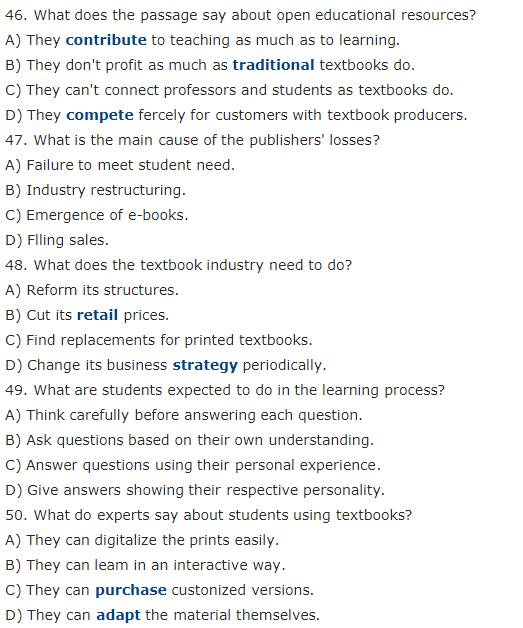
When we think of animals and plants, we have a pretty good way of dividing them into two distinct groups: one converts sunlight into energy and the other has to eat food to make its energy. Well, those dividing lines come crashing down with the discovery of a sea slug (海蛞蝓) that's truly half animal and half plant. It's pretty incredible how it has managed to hijack the genes of the algae (藻类) on which it feeds.
The slugs can manufacture chlorophyll, the green pigment (色素) in plants that captures energy from sunlight, and hold these genes within their body. The term kleptoplasty is used to describe the practice of using hijacked genes to create nutrients from sunlight. And so far, this green sea slug is the only known animal that can be truly considered solar-powered, although some animals do exhibit some plant-like behaviors. Many scientists have studied the green sea slugs to confirm that they are actually able to create energy from sunlight.
In fact, the slugs use the genetic material so well that they pass it on to their future generations. Their babies retain the ability to produce their own chlorophyll, though they can't generate energy from sunlight until they've eaten enough algae to steal the necessary genes, which they can't yet produce on their own.
"There's no way on earth that genes from an alga should work inside an animal cell," says Sidney Pierce from the University of South Florida. "And yet here, they do. They allow the animal to rely on sunshine for its nutrition. So if something happens to their food source, they have a way of not starving to death until they find more algae to eat."
The sea slugs are so good at gathering energy from the sun that they can live up to nine months without having to eat any food. They get all their nutritional needs met by the genes that they've hijacked from the algae.
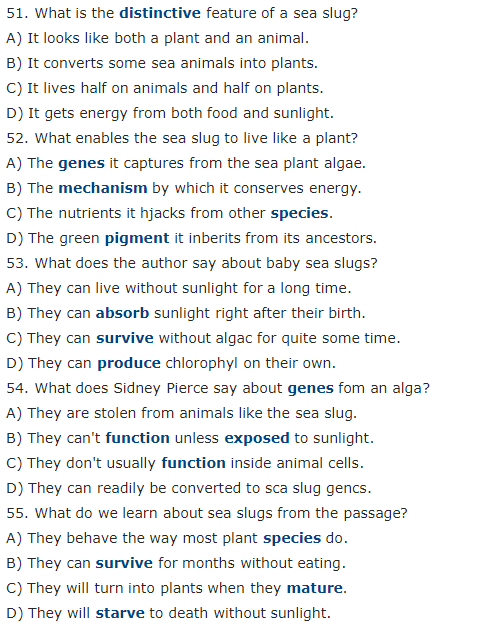
For this part, you are allowed 30 minutes to write a letter to a foreign friend who wants to teach English in China. Please recommend a city to him. You should write at least 120 words but no more than 180 words.
A) We've always been a hands-on, do it-yourself kind of nation. Ben Franklin, one of America's founding fathers, didn't just invent the lightning rod. His creations include glasses, innovative stoves and more.
B) Franklin, who was largely self-taught, may have been a genius, but he wasn't really an exception when it comes to American making and creativity.
C) The personal computing revolution and philosophy of disruptive innovation of Silicon Valley grew, in part, out of the creations of the Homebrew Computer Club, which was founded in a garage in Menlo Park, California, in the mid-1970s. Members-including guys named Jobs and Wozniak-started making and inventing things they couldn't buy.
D) So it's no surprise that the Maker Movement today is thriving in communities and some schools across America. Making is available to ordinary people who aren't tied to big companies, big defense labs or research universities. The maker philosophy echoes old ideas advocated by John Dewey, Montessori, and even ancient Greek philosophers, as we pointed out recently.
E) These maker spaces are often outside of classrooms, and are serving an important educational function. The Maker Movement is rediscovering learning by doing, which is Dewey's phrase from 100 years ago. We are rediscovering Dewey and Montessori and a lot of the practices that they pioneered that have been forgotten or at least put aside. A maker space is a place which can be in a school, but it doesn't look like a classroom. It can be in a library. It can be out in the community. It has tools and materials. It's a place where you get to make things based on your interest and on what you, re learning to do.
F) Ideas about learning by doing have struggled to become mainstream educationally, despite being old concepts from Dewey and Montessori, Plato and Aristotle, and in the American context, Ralph Emerson, on the value of experience and self-reliance. It's not necessarily an efficient way to learn. We learn, in a sense, by trial and error. Learning from experience is something that takes time and patience. It's very individualized. If your goal is to have standardized approaches to learning, where everybody learns the same thing at the same time in the same way, then learning by doing doesn't really fit that mold anymore. It's not the world of textbooks. It's not the world of testing.
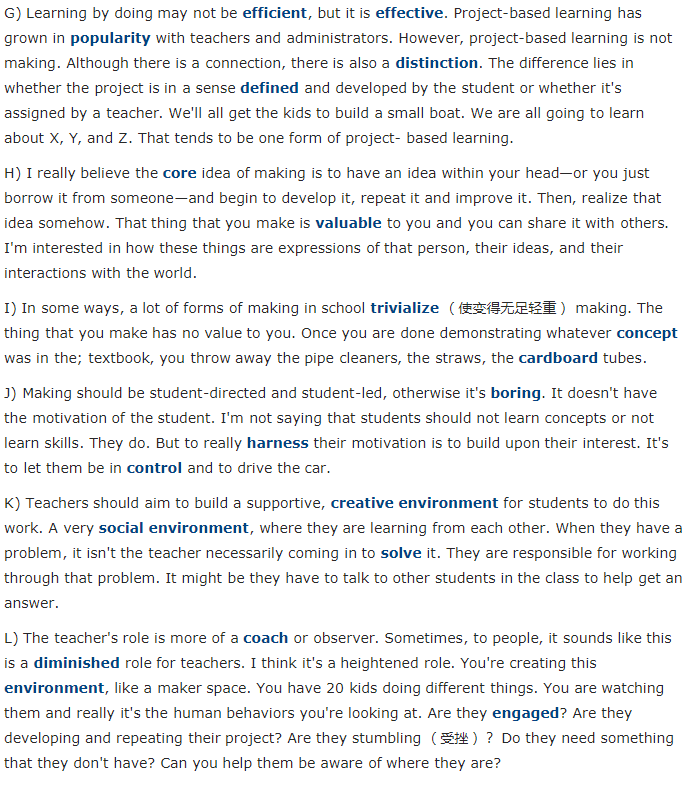
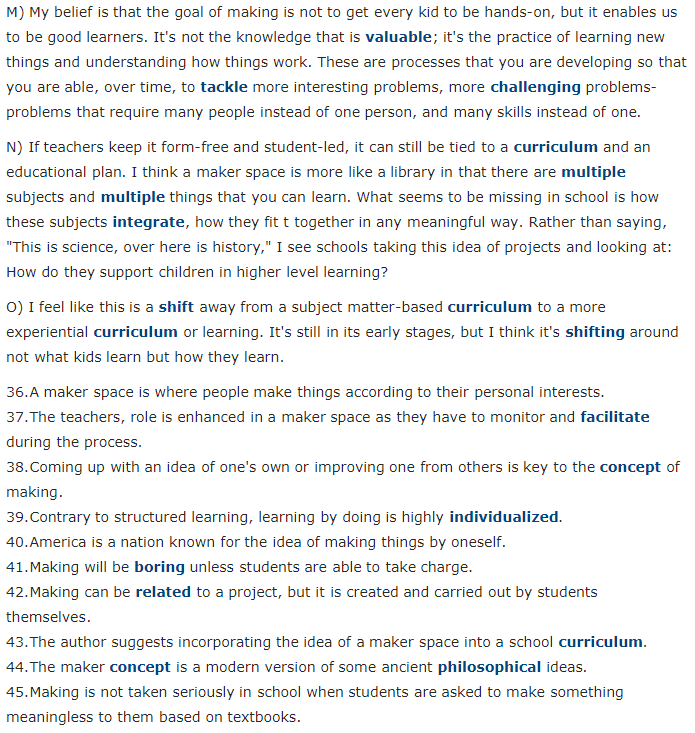
Professor Ashok Goel of Georgia Tech developed an artificially intelligent teaching assistant to help handle the enormous number of student questions in the online class, Knowledge-Based Artificial Intelligence. This online course is a core requirement of Georgia Tech's online Master of Science in Computer Science program. Professor Goel already had eight teaching assistants, but that wasn't enough to deal with the overwhelming number of daily questions from students.
Many students drop out of online courses because of the lack of teaching support. When students feel isolated or confused and reach out with questions that go unanswered, their motivation to continue begins to fade. Professor Goel decided to do something to remedy this situation and his solution was to create a virtual assistant named Jill Watson, which is based on the IBM Watson platform.
Goel and his team developed several versions of Jill Watson before releasing her to the online forums. At first, the virtual assistant wasn't too great. But Goel and his team sourced the online discussion forum to find all the 40,000 questions that had ever been asked since the class was launched. Then they began to feed Jill with the questions and answers. After some adjustments and sufficient time, Jill was able to answer the students' questions correctly 97% of the time. The virtual assistant became so advanced and realistic that the students didn't know she was a computer. The students, who were studying artificial intelligence, were interacting with the virtual assistant and couldn't tell it apart from a real human being. Goel didn't inform them about Jill's true identity until April 26. The students were actually very positive about the experience.
The goal of Professor Goel's virtual assistant next year is to take over answering 40% of all the questions posed by students on the online forum. The name Jill Watson will, of course, change to something else next semester. Professor Goel has a much rosier outlook on the future of artificial intelligence than, say, Elon Musk, Stephen Hawking, Bill Gates or Steve Wozniak.
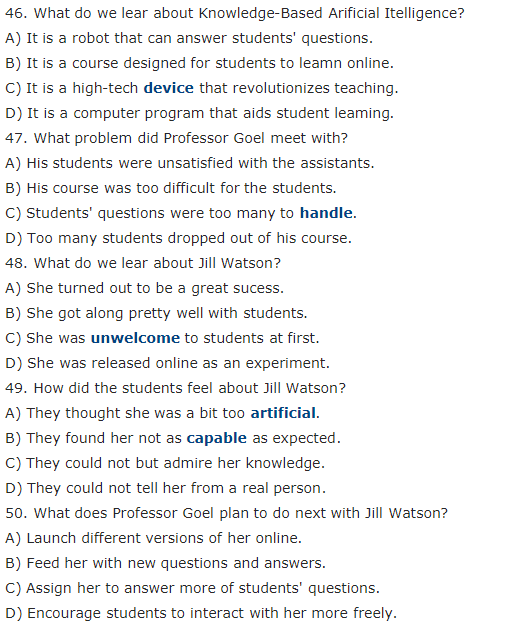
Thinking small, being engaging, and having a sense of humor don't hurt. Those are a few of the traits of successful science crowdfunding efforts that emerge from a recent study that examined nearly 400 campaigns. But having a large network and some promotional skills may be more crucial.
Crowdfunding, raising money for a project through online appeals, has taken off in recent years for everything from making movies to producing water-saving gadgets. Scientists have tried to tap Internet donors, too, with mixed success. Some raised more than twice their goals, but others have fallen short of reaching even modest targets.
To determine what separates science crowdfunding triumphs from failures, a team led by science communications scholar Mike Sch?fer of the University of Zurich examined the content of the webpages for 371 recent campaigns.
Four traits stood out for those that achieved their goals, the researchers report in Public Understanding of Science. For one, they use a crowdfunding platform that specializes in raising money for science, and not just any kind of project. Although sites like Kickstarter take all comers, platforms such as Experiment.com and Petridish.org only present scientific projects. For another, they present the project with a funny video because good visuals and a sense of humor improved success. Most of them engage with potential donors, since projects that answered questions from interested donors fared better. And they target a small amount of money. The projects included in the study raised $4,000 on average, with 30% receiving less than $1,000. The more money a project sought, the lower the chance it reached its goal, the researchers found.
Other factors may also significantly influence a project's success, most notably, the size of a scientist's personal and professional networks, and how much a researcher promotes a project on their own. Those two factors are by far more critical than the content on the page. Crowdfunding can be part of researchers' efforts to reach the public, and people give because "they feel a connection to the person" who is doing the fundraising—not necessarily to the science.
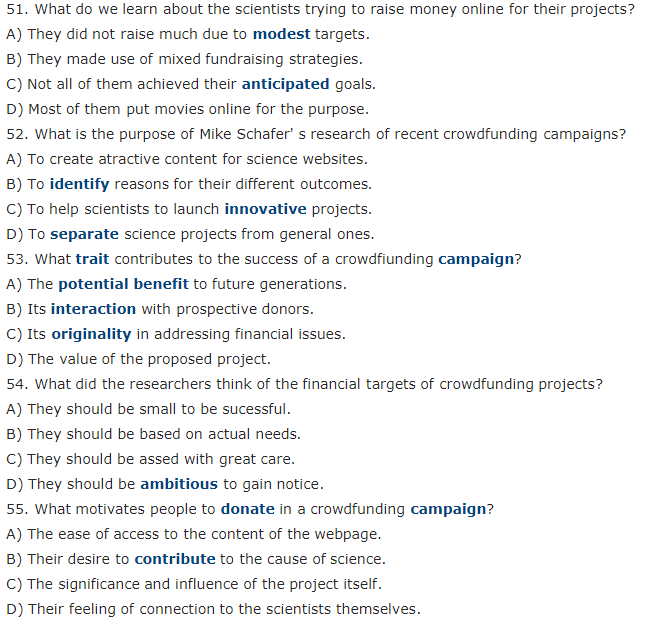
Directions: For this part, you are allowed 30 minutes to write a letter to a foreign friend who wants to study in China. Please recommend a university to him. You should write at least 120 words but no more than 180 words.
Directions: For this part, you are allowed 30 minutes to write a letter to a foreign friend who wants to teach English. Please recommend a city to him. You should write at least 120 words but no more than 180 words.
For this part, you are allowed 80 minutes to write a news report to your campus newspaper on a volunteer activity organized by your Student Union to assist elderly people in the neighborhood. You should write at least 120 words but no more than 180 words.
Ships are often sunk in order to create underwater reefs (暗礁) perfect for scuba diving (水肺式潜泳) and preserving marine __26__. Turkish authorities have just sunk something a little different than a ship, and it wouldn't normally ever touch water, an Airbus A300. The hollowed-out A300 was __27__ of everything potentially harmful to the environment and sunk off the Aegean coast today. Not only will the sunken plane __28__ the perfect skeleton for artificial reef growth, but authorities hope this new underwater attraction will bring tourists to the area.
The plane __29__ a total length of 54 meters, where experienced scuba divers will __30__ be able to venture through the cabin and around the plane's __31__ Aydin Municipality bought the plane from a private company for just under US $ 100, 000, but they hope to see a return on that __32__ through the tourism industry. Tourism throughout Turkey is expected to fall this year as the country has been the __33__ of several deadly terrorist attacks. As far as sunken planes go, this Airbus A300 is the largest __34__ sunk aircraft ever.
Taking a trip underwater and __35__ the inside of a sunken A300 would be quite an adventure, and that is exactly what Turkish authorities are hoping this attraction will make people think. Drawing in adventure seekers and experienced divers, this new artificial Airbus reef will be a scuba diver's paradise (天堂).
A) create
B) depressed
C) eventually
D) experiences
E) exploring
F) exterior
G) habitats
H) innovate
I) intentionally
J) investment
K) revealing
L) stretches
M) stripped
N) territory
O) victim